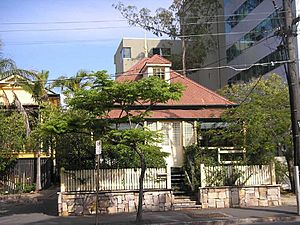Bellmount, Spring Hill facts for kids
Quick facts for kids Bellmount |
|
|---|---|

Bellmount, 2007
|
|
| Location | 71 St Pauls Terrace, Spring Hill, City of Brisbane, Queensland, Australia |
| Design period | 1870s - 1890s (late 19th century) |
| Built | c. 1880 - c. 1900 |
| Official name: Bellmount | |
| Type | state heritage (built) |
| Designated | 21 October 1992 |
| Reference no. | 600311 |
| Significant period | 1880s-1900s (fabric) 1870s/1880s (historical) |
| Significant components | residential accommodation - main house |
| Lua error in Module:Location_map at line 420: attempt to index field 'wikibase' (a nil value). | |
Bellmount is a special old house located at 71 St Pauls Terrace in Spring Hill, Brisbane, Queensland, Australia. It was built a long time ago, around 1880 to 1900. This house is considered important because of its history and unique style. It was added to the Queensland Heritage Register on October 21, 1992. This means it's officially protected as a significant part of Queensland's history.
Contents
Bellmount's Story
Bellmount started as a small timber cottage built in 1880. It was made for Martin McLeod, who worked as a bank messenger for the Union Bank of Australia.
How Spring Hill Grew
The area of Spring Hill began to develop in the 1850s and 1860s. This happened after the government divided up land north of Brisbane's town centre. Spring Hill became mostly a place where people lived. It didn't have many shops or factories.
People with more money built big houses on the higher parts of the land. These areas, like Wickham and Gregory Terraces, offered great views and cool breezes. They also had good natural drainage. People with less money built simpler timber houses. These were on smaller blocks of land in the lower areas.
St Pauls Terrace, where Bellmount is, was a slightly lower ridge road. Churches and schools were built there. In the 1880s, during a time of growth, more fancy homes and boarding houses appeared in Spring Hill. Simple pyramid-roofed houses, like Bellmount, became very popular for working-class families. This style remained common until the 1890s.
Who Owned Bellmount?
The land for Bellmount was first given to David McConnel in 1853. This was a large piece of land. In 1872, it was divided into smaller plots. William Cookslerf bought one of these plots.
Later, this plot was divided again. Martin McLeod bought one of these smaller sections in 1880. This is the spot where Bellmount now stands at 71 St Pauls Terrace. McLeod built a typical four-room timber cottage there. It had a pyramid-shaped roof. Later, two more rooms were added to the back of the house. There's also an attic inside the main roof. It looks like this might have been added later too.
The McLeod family owned Bellmount for three generations, until 1976. Today, the building is used as offices.
What Bellmount Looks Like
Bellmount is on the south side of St Pauls Terrace. It's across from Brisbane Central State School. It sits among a few other timber houses. The house is mainly a four-room cottage with a pyramid roof. More rooms were added to the back. The building takes up almost the whole width of its property. It is also quite close to the street.
Because the land slopes, the front of the house is raised on timber stumps. The back of the house is closer to the ground. The top of the steeply sloped corrugated iron roof has a timber decoration called a finial. A single dormer window sticks out from the roof towards the street. A skylight is on the back slope of the roof.
The original house walls are covered with wide timber boards called chamferboards. Most of the original windows, which have four glass panes, are still there. The newer part at the back of the house has different timber cladding called weatherboards. Its windows match the dormer window.
The front porch, or verandah, has a hipped roof that curves outwards. It has timber posts, brackets, and top rails. There's also decorative cast iron balustrading. Two screen doors with a criss-cross pattern lead to the verandah. An old wooden panel with angled slats is at one end of the verandah. The back verandah is built more simply. It has been filled in with different materials like corrugated iron and fibreglass. The floor of the back verandah is made of bricks.
Inside Bellmount
The main part of the house is square. It has two bedrooms on one side. On the other side, there's a combined room that used to be a parlour and a drawing room. The two rooms added later at the back are a kitchen and an extra bedroom.
The attic bedroom is in the main roof space. You get to it by a narrow set of timber stairs from the old drawing room. A bathroom was made by closing off part of the back verandah. The inside walls of the house are made of single layers of vertical timber boards. These boards are wider in the original part of the house and narrower in the newer back section.
Why Bellmount is Important
Bellmount was added to the Queensland Heritage Register on October 21, 1992. It met several important requirements:
- Shows Queensland's History: Bellmount, built in 1880, helps us understand how Brisbane's inner suburbs, especially Spring Hill, grew in the early days.
- Unique Features: The attic in Bellmount is an unusual example of using space. This was not common in Queensland because attics could get very hot.
- Typical House Style: The house is a great example of a common type of worker's cottage. These four-room, pyramid-roofed homes were very popular from the 1880s to the 1890s.
- Looks Good: Bellmount adds a lot to the look of St Pauls Terrace. Its size, shape, and the materials used make it an important part of the street's history.

